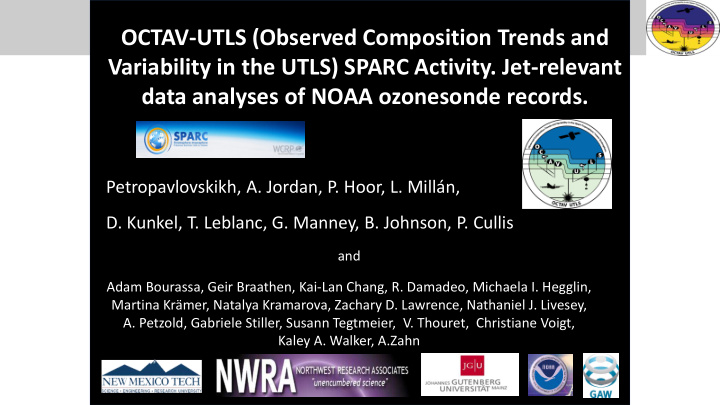



OCTAV-UTLS (Observed Composition Trends and Variability in the UTLS) SPARC Activity. Jet-relevant data analyses of NOAA ozonesonde records. Petropavlovskikh, A. Jordan, P. Hoor, L. Millán, D. Kunkel, T. Leblanc, G. Manney, B. Johnson, P. Cullis and Adam Bourassa, Geir Braathen, Kai-Lan Chang, R. Damadeo, Michaela I. Hegglin, Martina Krämer, Natalya Kramarova, Zachary D. Lawrence, Nathaniel J. Livesey, A. Petzold, Gabriele Stiller, Susann Tegtmeier, V. Thouret, Christiane Voigt, Kaley A. Walker, A.Zahn
OCTAV UTLS : Motivation Riese et al., 2012 strong sensitivity of surface temperature to changes of radiatively active trace gases in the UTLS
OCTAV UTLS : Motivation UNEP/WMO Ozone assessment, 2018, SPARC/WMO LOTUS Report, 2019 UTLS: Large range of uncertainty Sign and magnitude of trends
OCTAV UTLS : Motivation What are main causes of the variability/uncertainties of the chemical composition in the UTLS? - Limitations by the observations (coverage, resolution, measurement uncertainty) - Dynamical variability Can we better account for the dynamically induced SPARC/WMO LOTUS Report, 2019 Large range of uncertainty variability to reduce the variability of the composition? Sign and magnitude of trends
OCTAV – UTLS Observing Composition Trends and Variability in the UTLS Objective: Develop unified consistent geophysically-based metrics to account for dynamical induced variability Previous Research: Strat/trop exchange is enhanced in the vicinity of the Jets ENSO+QBO+BDC influence jet location and tropopause Method: Apply the same metrics (e.g. tropopause and jet relative coordinates) to multiple data sets from different platforms What are the best coordinates to account for the variability induced by dynamics?
OCTAV UTLS: Methods G. Manney L. Millan + DIFFERENT GEOPHYSICAL COORDINATE SYSTEMS
OCTAV UTLS: Methods Combined tropopause referenced and jet-relative coordinates (STJ, PJ) STJ latitude / STJ altitude, all longitudes STJ latitude / TP altitude Clear separation between different regions and ozone gradients JETPAC (Manney et al., 2011, 2014, 2017)
OCTAV UTLS: overcoming sampling limitations MLS satellite (MAM 2010-2018) Boulder, ozonesonde (MAM 2010-2018)
OCTAV-UTLS method: long-term changes Boulder, 1990-2000 median Boulder, 2010-2018 median
OCTAV-UTLS method: long-term changes Low sampling, less than 10 % Boulder, 1990-2000 median Boulder, 2010-2019 median
OCTAV-UTLS method: long-term changes Boulder, 1990-2000 median Boulder, 2010-2019 median Increase above jet on Equator-side Decrease below jet on Polar-side
OCTAV Science questions ● Can we identify long-term composition changes in the UTLS from existing UTLS datasets? It requires further statistical analyses for significance and sampling impacts ● How well can we quantify trends in the UTLS composition derived from different observation techniques with limited temporal and spatial sampling ? New coordinates. ● Can we estimate/quantify the impact of major natural modes of interannual variability (e.g., QBO, NAM, ENSO, NAO) on UTLS composition? Future investigation ● How do trends in UTLS composition affect the radiative balance in the UTLS and what are the critical impacts of that for weather and climate, including changes in wave activity and stratospheric influences? ● What future measurement strategies are needed to improve our understanding of the UTLS trends and variability?
Future work ● Determine the best coordinates for trend analyses ● Compare ground-based and satellite data in jet- relevant coordinates ● Compare different geographical locations (i.e. impacts from QBO, ENSO and BDC transport) ● Do trend analyses in UTLS.
Recommend
More recommend